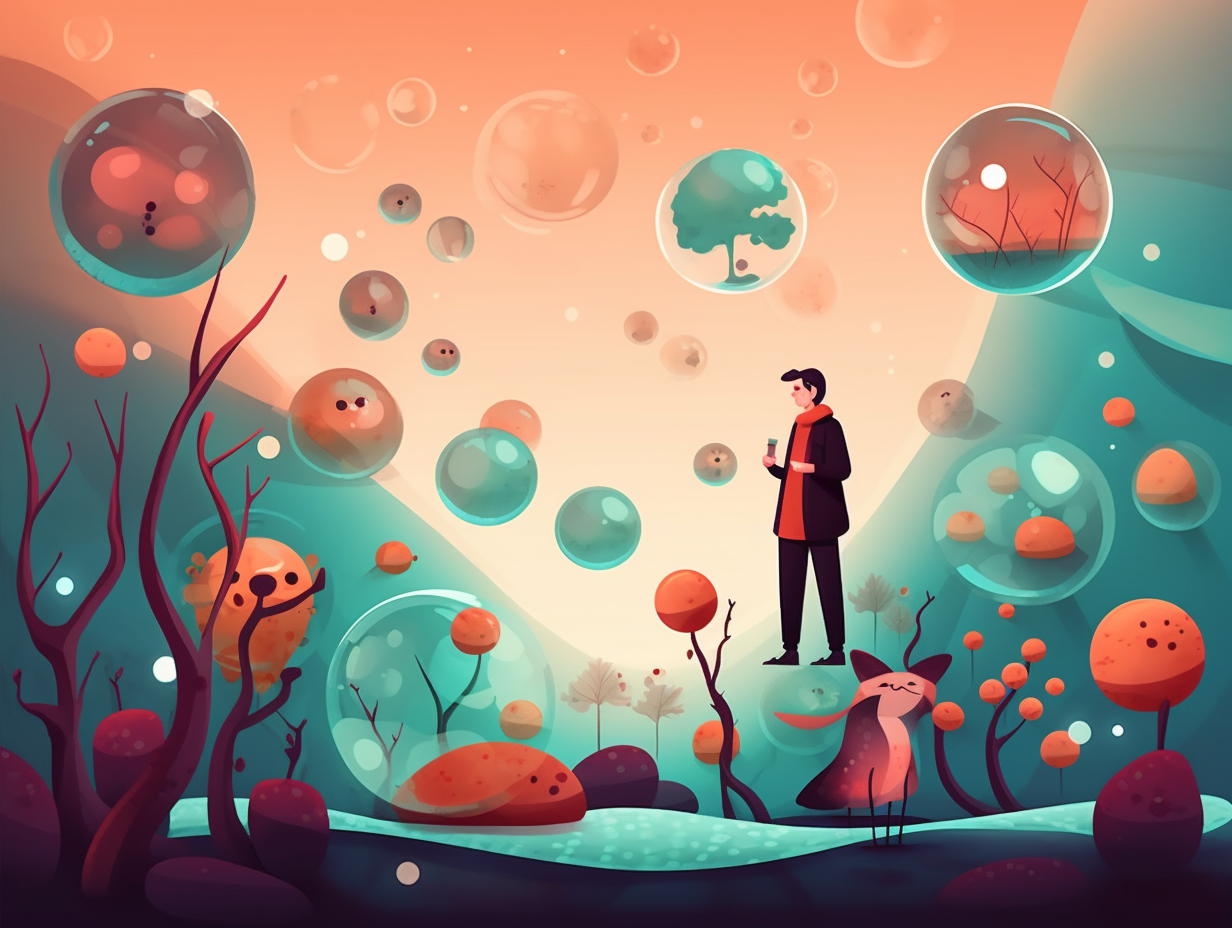Discover the Intriguing World Within: Top 14 Fun Facts About Cytoplasm

1. Lysosomes: Cellular Garbage Disposals
Kitchen enthusiasts, listen up: cells have their very own garbage disposal units too! Meet the lysosomes: these mighty little organelles chow down on waste materials, expired cell bits, and the occasional pesky virus or bacteria. They get their hands (or enzymes) dirty in a process called autophagy, ensuring their cellular home remains spotless and fully functional.
Source => courses.lumenlearning.com
2. Cytoplasm: Ultimate Pool Party
If the cytoplasm were a pool party, it would be the ultimate mixer where organelles mingle and bustle in gel-like marvel, instead of floating lazily atop a sea of H2O: The cytoplasm is the dynamic, watery substance that fills the cell, actively regulating its composition for cellular functions like movement, division, and communication – truly the life of the cellular soiree!
Source => ncbi.nlm.nih.gov

Did you know salamanders are slimy superstars that can regenerate lost limbs, organs, and tissues? Discover their amazing abilities in our fun facts about cells!
=> Fun Facts about Cells
3. Plant Cells: Speedy Cytoplasm Racers
Step aside, Speedy Gonzales, there's a new rapid racer in town – cytoplasmic streaming in plants: This thrilling phenomenon involves the movement of nutrients, metabolites, and organelles through cytoplasm at speeds faster than diffusion, thanks to convection and the assistance of actin filaments and myosin motor proteins. Surprisingly, salt-tolerant plants take the slow lane in this race, conserving ATP for essential metabolic processes in their salty surroundings.
Source => sciencedirect.com
4. Cytoplasm: Jelly Donut's Secret City
Picture this: the cytoplasm is like the ultimate surprise inside a gooey jelly donut, except it's not filled with delicious jam, but with the bustling activities of a microscopic city. Intrigued? Here's the twist: the cytoplasm is actually a highly organized structure containing cytoskeletal components such as microtubules, actin filaments, and intermediate filaments, all working in harmony to maintain the cell's shape, and support key functions like movement and division.
Source => nature.com

5. Cytoplasm: Obstacle Course Adventure
Behold, the Cyto-lympics: In a world as vast as our own, the cytoplasm is a bustling metropolis of molecules, constantly on the move like restless tourists scampering about in search of the best gelato stand. Here, getting around is no simple stroll in the park, but more an obstacle course filled with dodgy taxi drivers and crowded sidewalks that would leave even the most skilled parkour experts scratching their heads: Within the cytoplasm, molecules face obstructions, crowding, and confinement, making solute mobility a tad tricky to predict – but a thrilling challenge to those molecules looking for an adventure in this lively cellular city!
Source => ncbi.nlm.nih.gov
6. Plant Cells: Masterminds of Mad Gab
Ever tried to decode a secret message, only to realize it's just a shopping list? That's child's play compared to how plant cells play Mad Gab with their cytoplasm: In the cytoplasm of plant cells, a complex process of gene expression and protein synthesis occurs, involving machinery such as mRNA, transfer RNAs, ribosomal RNAs, and protein factors that translate the mRNA into a polypeptide chain or protein, essential for their survival and photosynthesis!
Source => ncbi.nlm.nih.gov
7. Cellular Musical Chairs: Divide and Conquer
Imagine the cytoplasm as a microscopic metropolis hosting a city-wide, organellular game of musical chairs: whoever isn't quick enough to snatch a seat perishes! Hilarious prelude aside: cytoplasm is crucial to cell division, ensuring that dividing cells receive equal parts of organelles and cytoplasmic components, keeping the cellular circle of life going.
Source => nature.com
8. Myosin and Kinesin: Organelle Rideshare
Move over, Uber and Lyft, there's a new rideshare service in town for organelles: Myosin and Kinesin Mobile! This luxury transport service whisks cellular components to their destinations, all powered by ATP hydrolysis: Also known as the cellular VIPs, myosin and kinesin motor proteins chauffeur organelles along cytoskeletal filaments, with myosins cruising down actin highways and kinesins zipping along microtubule lanes - all part of the intriguing and bustling world of cytoplasm!
Source => ncbi.nlm.nih.gov
9. Parental Drama: Mitochondrial Inheritance
In a game of "Who's Your Daddy: Cellular Edition," nuclear DNA might demand a paternity test, but when it comes to mighty mitochondria and cool chloroplast 'rents, they know precisely where they came from: Mitochondrial and chloroplast DNA are usually inherited from just one parent, often the mother. In humans, children inherit mitochondrial DNA only from their mom, and these unique genes can even harbor mutations leading to genetic disorders, such as Kearns-Sayre syndrome, which results in muscle weakness, vision loss, and heart problems.
Source => khanacademy.org

10. The Flash of the Cellular World: Cytoskeleton
Next time you find yourself envious of speedy transportation like The Flash or a getaway car in an action film, look no further than the microscopic realm of cytoplasm for a dose of hullabaloo: It has no organs to zip around with, but relies on an ever-changing network of protein fibers called the cytoskeleton, making strides in shuttling molecules and organelles efficiently within the cell.
Source => khanacademy.org
11. Golgi Apparatus: Lipid and Cell Wall Artisans
Did you hear about the cytoplasm's elite members-only club called the Golgi apparatus? They're quite the lipid connoisseurs, handcrafting precious cell membrane ingredients while also moonlighting as plant cell wall artisans: The Golgi apparatus is the cytoplasmic site for synthesizing essential lipids such as sphingomyelin and glycolipids, which are vital components of cell membranes, and in plant cells, it also plays a major role in producing up to 80% of the complex polysaccharides that constitute the cell wall.
Source => ncbi.nlm.nih.gov
12. Cytoplasm: Protein Matchmaking and Party Planner
Cytoplasm: it's what's for dinner, if you're a protein in the cellular kitchen, that is! This bustling bazaar of microscopic master chefs is not just a Michelin-starred playground for molecules – it's a finely tuned arena that dictates cell-tastic events: From enzyme speed-dating to molecular traffic jams, the cytoplasm's complex chemistry lays the foundation for all cellular functions, helping proteins find their perfect match, and even turning it into a pool party with splashy liquid droplets!
Source => ncbi.nlm.nih.gov
13. Flex Your Muscles: Actin Filaments and Myosin
While the cytoplasm may not be the latest boutique gym offering "Actin Fit" classes for the new age fitness enthusiasts, it sure knows a thing or two about flexing its muscles for life's daily workout: With actin filaments and myosin working together, they contribute to cell movements such as muscle contractions, cell division, crawling movements across surfaces, and cell adhesion, proving that the best things come in microscopic packages.
Source => ncbi.nlm.nih.gov
14. Lysosomes: Multitasking Maestros and Fountain of Youth
Did you hear about the lysosomes' secret lives? These cytoplasmic maestros moonlight as waste disposal experts, metabolism regulators, and even potential key holders to the Fountain of Youth: In recent research, lysosomes have been found to be highly influential in cellular metabolism, longevity, and even neurodegenerative diseases like Alzheimer's. They are not only efficient waste recyclers but also have the ability to toggle between breaking down and building up, providing promising avenues for metabolic disease treatments like obesity.
Source => scientificamerican.com
Related Fun Facts




















